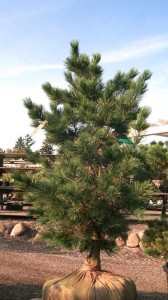Pine – Pruning, Winter Care and Fertilizing
 These large evergreens require little or no pruning in most cases. However, if extra density is desired, pruning can be done in early spring. Remove 1/3 to ½ of the terminal growth from the end of each branch. Do not remove any of the central leader at this time, rather wait until the new growth is approximately ½ expanded (in later spring) and pinch off 1/3 to ½ of the central leader’s new growth. If this is done at the proper time, a new terminal bud for the next year will form on the top of the new growth. If a central leader is lost, a new one can be established by tying a side shoot in an upright position. It can take up to 18 months for a new central leader to develop. Newly planted evergreens respond very well to fertilizing. Either granular, liquid or stake type fertilizers can be used. Granular fertilizers can be worked into the soil around the plant at a rate of 2 lbs or 2 pints per 100 square feet of planting bed. An alternative way to apply granular fertilizers starts with drilling or punching 6” deep holes at the drip line of the tree. Poured into these holes should be a total of 2 pounds of fertilizer per 1″ of trunk diameter (divided up and poured evenly between all of the holes). These holes should not be filled with more than 1/3 of the fertilizer and then they should be top filled with soil. This method of fertilization should only be done once a year, and is best done in late fall after leaf drop, or in early spring before bud break.
These large evergreens require little or no pruning in most cases. However, if extra density is desired, pruning can be done in early spring. Remove 1/3 to ½ of the terminal growth from the end of each branch. Do not remove any of the central leader at this time, rather wait until the new growth is approximately ½ expanded (in later spring) and pinch off 1/3 to ½ of the central leader’s new growth. If this is done at the proper time, a new terminal bud for the next year will form on the top of the new growth. If a central leader is lost, a new one can be established by tying a side shoot in an upright position. It can take up to 18 months for a new central leader to develop. Newly planted evergreens respond very well to fertilizing. Either granular, liquid or stake type fertilizers can be used. Granular fertilizers can be worked into the soil around the plant at a rate of 2 lbs or 2 pints per 100 square feet of planting bed. An alternative way to apply granular fertilizers starts with drilling or punching 6” deep holes at the drip line of the tree. Poured into these holes should be a total of 2 pounds of fertilizer per 1″ of trunk diameter (divided up and poured evenly between all of the holes). These holes should not be filled with more than 1/3 of the fertilizer and then they should be top filled with soil. This method of fertilization should only be done once a year, and is best done in late fall after leaf drop, or in early spring before bud break.
Liquid fertilizers (such as Miracle Gro ) are mixed with water and applied the same as you would water the plant (see product for specific details). This should be done three or four times per year starting in late April and ending in mid July. Stake type fertilizers can be used following the directions on the package. With any of the above techniques, a higher nitrogen mix should be used; 20-20-20 or similar mix is a good choices. Organic fertilizers, like manure, can also be used with good results. The material should be worked into open soil at a rate of one bushel per 1″ of trunk caliper or 100square feet of bed area. As evergreens mature, less fertilizing or lower nitrogen mixes should be used. These evergreens need very little winter care, but should be checked now and then for snow damage. Branches heavily laden with snow should carefully cleared off. After a dry fall season, a good watering in early November will also benefit the plant.
